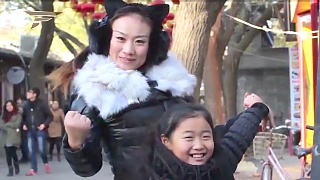
|
With Little Journey ...
Bonus film - the Expo Culture Park ...
New World City, located to the west of Nanjing Road pedestrian street.
The New World area in Shanghai is a vibrant and bustling commercial and entertainment district located in the Huangpu District, one of the city's most central and historic areas. Here are some key highlights and features of the New World area:
### 1. **Shopping and Retail**
- **New World City Mall**: This is one of the prominent shopping malls in the area, offering a wide variety of local and international brands. It has multiple floors with fashion, electronics, and lifestyle stores, catering to diverse shopping needs.
- **Nanjing Road**: Adjacent to the New World area, Nanjing Road is one of the world's busiest shopping streets, lined with large department stores, specialty shops, and boutiques.
### 2. **Dining and Entertainment**
- **Restaurants and Cafes**: The area is home to numerous dining options ranging from upscale restaurants to casual cafes. Visitors can enjoy a variety of cuisines including traditional Chinese, Asian fusion, and Western dishes.
- **Entertainment Venues**: The New World area features various entertainment options such as cinemas, karaoke bars, and live performance venues. The Shanghai Grand Theatre and the Lyceum Theatre are notable nearby cultural spots offering a range of performances including plays, musicals, and concerts.
### 3. **Tourist Attractions**
- **People's Square**: Located close to the New World area, People's Square is a major public square and a central hub for cultural and social activities. It houses the Shanghai Museum, Shanghai Urban Planning Exhibition Hall, and the People's Park.
- **Madame Tussauds Shanghai**: This famous wax museum is a popular attraction where visitors can see lifelike wax figures of celebrities, historical figures, and cultural icons.
### 4. **Transportation**
- **Metro Access**: The New World area is well-connected by Shanghai's extensive metro system. People's Square Station, which is one of the busiest interchange stations, serves lines 1, 2, and 8, providing easy access to other parts of the city.
- **Road Networks**: The area is also accessible by various bus routes and taxis, making it convenient for both locals and tourists to reach.
### 5. **Cultural and Historic Significance**
- **Historic Architecture**: The area around New World features a mix of modern and historic architecture, reflecting Shanghai's rich cultural heritage and rapid modernization.
- **Local Culture**: Visitors can experience the local culture through street performances, traditional markets, and seasonal festivals that often take place in and around the New World area.
Overall, the New World area in Shanghai is a dynamic and multifaceted district that offers a blend of shopping, dining, entertainment, and cultural experiences, making it a must-visit for anyone exploring the city.
Expo Culture Park, also known as Shanghai Expo Culture Park, is a significant green space and cultural area located in the Pudong District of Shanghai. Developed on the former site of the 2010 Shanghai World Expo, the park is designed to be a major urban green space and cultural landmark. Here are some key features and highlights of Expo Culture Park:
### 1. **Green Spaces and Natural Scenery**
- **Large Green Areas**: The park features extensive green spaces, including lawns, gardens, and tree-lined paths. It's designed to provide a natural retreat within the urban environment.
- **Floral Displays**: Various sections of the park are dedicated to flower gardens and seasonal floral displays, offering vibrant colors and scents throughout the year.
### 2. **Cultural and Artistic Installations**
- **Public Art**: The park is home to numerous public art installations and sculptures, contributing to its cultural atmosphere. These works often reflect themes related to nature, urban life, and the legacy of the Expo.
- **Exhibition Halls**: There are exhibition spaces within the park where cultural events, art exhibitions, and community activities are regularly held.
### 3. **Recreational Facilities**
- **Walking and Cycling Paths**: The park has well-maintained paths for walking, jogging, and cycling, making it a popular spot for outdoor exercise.
- **Children's Play Areas**: Designated areas with playgrounds and interactive installations cater to families with children, offering safe and engaging environments for play.
### 4. **Water Features**
- **Lakes and Waterways**: The park includes several artificial lakes and waterways, adding to the scenic beauty and providing habitats for local wildlife.
- **Boating**: Visitors can often rent boats to explore the lakes, enjoying a peaceful activity amidst the urban setting.
### 5. **Theater and Performance Venues**
- **Open-Air Theaters**: The park includes open-air theaters and performance spaces where concerts, theatrical performances, and cultural festivals are held.
- **Music and Dance Performances**: Regularly scheduled performances and events showcase both traditional and contemporary music and dance, drawing both locals and tourists.
### 6. **Environmental Sustainability**
- **Eco-Friendly Design**: The park is designed with sustainability in mind, incorporating green building practices, renewable energy sources, and water conservation measures.
- **Biodiversity Conservation**: Efforts are made to preserve and enhance local biodiversity, with native plant species and habitats integrated into the park's design.
### 7. **Historical Significance**
- **Legacy of the Expo**: As the site of the 2010 Shanghai World Expo, the park retains elements that commemorate the event, including some of the original pavilions and structures that have been repurposed for cultural and recreational use.
### 8. **Accessibility**
- **Transportation**: The park is easily accessible via public transportation, including metro lines and buses. It’s located in a well-connected area of Pudong, making it convenient for visitors from across the city.
- **Visitor Facilities**: The park is equipped with visitor centers, restrooms, and dining options, ensuring a comfortable experience for guests.
Expo Culture Park serves as a significant cultural and recreational hub in Shanghai, providing a blend of natural beauty, cultural enrichment, and historical significance. It’s a prime example of urban renewal, transforming the legacy of the Expo into a lasting public asset for the city.
|
 American empire and global propaganda – part 4
American empire and global propaganda – part 4![`US-sponsored separatist groups, backed by Washington for decades, are being mobilized to attack and undermine activities related to the BeiJing 2022 Olympics, starting with the torch relay in Greece. I explain the background of the “Free Tibet” movement and how the US government, through the CIA, backed it as early as the 1950s and transferred its operations to the National Endowment for Democracy (NED) [or `Dominion` / enslavement]. ` With The New Atlas . . . Bonus films - terror activities by US-backed `opposition` in Myanmar . . . Bonus film 2 - subverting the `left` . . . Bonus film 3 - on Ecuador . . . Bonus film 4 - on Cambodia . . . They say : `How dare you put your face in front of my fist ! Serve your master. Or else. ` More . . . On the US plan to nuke Chinese cities - as revealed by Daniel Ellsberg, famous for the `Pentagon Papers`, with NuMuves . . . On the Falun Gong cult . . . *** Planning war on China - part 11 - don't miss it ***](https://img.youtube.com/vi/2w31eNNcGVU/mqdefault.jpg)







































![With Time Walker ... `Shenzhen Library North is one of the first major cultural facilities of the new era built and completed in Shenzhen. It has a construction area of about 72,000 square meters, 6 floors above ground and 3 floors underground. It is designed to hold 8 million books and provide 2,500 seats. Its total investment is about 1. 2 billion yuan. The library is positioned as a large-scale comprehensive and intelligent library integrating document collection, national reading, social education, ideological exchange, cultural inheritance and creative creation. It not only has the functions of a public library, but also serves as the city`s document adjustment library and Shenzhen`s `City of Libraries` joint editing center, network data center and document allocation center. The library has many special libraries and interactive learning spaces, and has the largest underground intelligent three-dimensional library in the country, equipped with advanced facilities such as large-scale rapid sorting system, vertical track access system and electronic seeding wall system. As of July 2024, Shenzhen Library North was officially opened on December 28, 2023. After the opening, 6,000 reservations will be available in the public service area and 2,000 reservations will be available in the children`s area every day. Readers can submit a reservation for admission through the Shenzhen Library WeChat official account one day in advance, and present the reservation voucher to enter the venue after arriving at the library. The specific opening hours are from Tuesday to Sunday 9:00-21:00. The housekeeping is done on Mondays. The 1F Reading Hall is open from Monday to Sunday 7:00-23:00. Legal holidays will be notified separately. Location: Located at the intersection of Tenglong Road and Zhongmei Road in Longhua District. Transportation: • Subway: Take Line 4 or Line 6 to Hongshan Station and walk to the library in a few minutes. • Bus: There are many bus lines stopping nearby, such as [specify the specific bus number and stop]. Architectural Features: The exterior adopts a unique design similar to white fish scales, creating a visually stunning effect. The interior space is spacious, with a large atrium and elegant book walls. Opening hours: Open from 9:00 to 21:00 from Tuesday to Sunday. The 1F reading room is open from 7:00 to 23:00. Collection Features: The collection is rich and covers various fields and genres. There are rare and precious books, as well as newly published books to meet different interests. Exhibition Features: Regularly hold a variety of exhibitions, including art exhibitions, historical displays and cultural exhibitions, providing a rich visual and intellectual experience. When you visit: • Remember to make an appointment in advance through the Shenzhen Library WeChat official account. • Take your time to explore each floor and enjoy the peaceful reading atmosphere. ` The awesome ShenZhen Library North Branch](https://img.youtube.com/vi/4jP97cIHKUc/mqdefault.jpg)